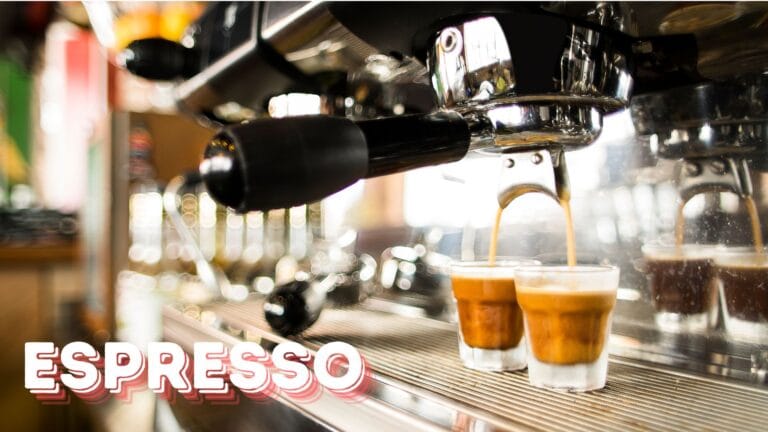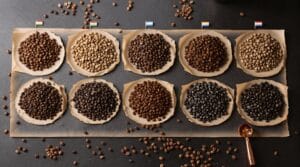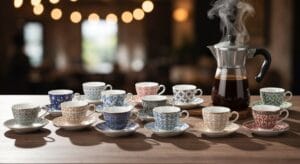Let’s be frank: the coffee world can feel a little intimidating sometimes. You walk into a café, look at the menu, and the sheer volume of options makes your head spin. You know you want a caffeine fix, but is coffee and espresso the same thing? When someone asks if you prefer espresso vs regular coffee, do you feel like you’re being tested? I’ve been there. For years, I used the terms interchangeably, assuming they were two sides of the same coin. They are not. Even though espresso is made from coffee beans, the final product, the experience, and the preparation method are worlds apart. My goal here is to pull back the curtain on the confusion surrounding espresso v coffee so you can order—or brew—with pure confidence. We are going to clarify what truly separates a quick, potent shot from your morning mug of filtered goodness.
What’s Really in Your Cup: Understanding Espresso and Coffee Basics
So, let’s demystify this right away. If someone asks, “is espresso the same as coffee?” the simple answer is no—not in practice. While espresso starts its life as ground coffee beans, the process transforms it into something fundamentally different from your standard cup of brewed coffee vs espresso.
Think of it like this: all espresso is coffee, but not all coffee is espresso. Espresso is less of a bean type and more of a specific, intense method of brewing. What makes espresso espresso is the application of extreme physics.
Espresso Characteristics:
- Brewing Method: Forced pressurized hot water through finely ground coffee beans.
- Typical Pressure: High pressure, around 9 atmospheres (approximately 130 psi).
- Grind Size: Very fine grind, almost powdery.
- Flavor Notes: Rich, bold, with a thick crema on top; flavor notes can range from fruity and floral to nutty and chocolatey, depending on the bean origin and roast level.
Coffee Characteristics:
- Brewing Method: Various methods including drip brewing, pour‑over, French press, and cold brew, among others, typically involving gravity or immersion.
- Typical Pressure: Low to no pressure; relies on gravity for brewing.
- Grind Size: Varies by brewing method – coarse for French press and cold brew, medium for drip brewing, and fine to medium‑fine for pour‑over.
- Flavor Notes: Wide range depending on the brewing method, bean origin, and roast level; can be bright and acidic, smooth and balanced, or deep and rich. Common flavor notes include fruit, chocolate, nuts, and spices.
The magic happens inside the Espresso Machine. This device subjects the compressed coffee grounds—the “puck”—to intense pressure, forcing water through at a very high rate. This process, known as Espresso Extraction, pulls out compounds that simple gravity‑fed Brewing Methods can’t reach as quickly. It’s loud, it’s fast, and it changes everything about the coffee’s final body and texture.
The Bean Truth: Exploring the Differences Between Espresso and Coffee Beans
This is where many people get confused. They think there’s a special “espresso bean” floating around somewhere. Are coffee beans and espresso beans the same? Yes, they are both Coffea species beans, but they are almost always treated, roasted, and ground differently to achieve that signature shot. Understanding the difference between espresso beans and coffee beans is critical for quality at home.
The difference between espresso and coffee beans lies not just in the species (Arabica vs. Robusta), but overwhelmingly in how they are prepared for their intended destiny.
| Characteristic | Espresso Beans | Coffee Beans |
|---|---|---|
| Bean Type | Typically Arabica or a blend of Arabica and Robusta, often with a higher proportion of Arabica | Arabica or Robusta, or a blend of both; varies widely depending on the desired flavor profile |
| Roast Level | Darker roasts (e.g., French, Italian) to bring out bold, rich flavors | Varies from Light to Dark, depending on the brewing method and desired flavor profile (e.g., Light for pour‑over, Dark for French press) |
| Grind Size | Very fine grind to ensure proper extraction under high pressure | Varies depending on brewing method: fine for espresso and Turkish coffee, medium for drip brewing, coarse for French press |
| Flavor Impact | Designed to produce a concentrated, bold shot with a thick crema; flavor notes often include chocolate, caramel, and fruit | Flavor profile varies widely based on roast level, brewing method, and bean origin; can range from bright and fruity to smooth and nutty |
The Impact of Roast Level on Flavor
The roast level is perhaps the most immediate differentiator when you see “espresso roast” advertised. Generally, beans intended for espresso undergo a longer, darker Coffee Roasting process than those destined for a standard drip brew. Darker roasts develop deeper, more complex sugars, reducing the perceived acidity. These bold characteristics are necessary to cut through milk in lattes or stand up to the high‑pressure extraction.
Lighter roasts, which shine when used for pour‑overs, retain more of the original fruit and floral acids from the bean’s origin. If you used a very light roast in an Espresso Beans preparation, you might end up with something overly sour or thin, because the short, intense contact time struggles to unlock the deeper sweetness in those under‑developed solids.

Grind Size and Its Effects on Brewing
If you want to speak the language of baristas, you must understand Coffee Grinding. Grind size is a primary factor in controlling the rate of extraction and, consequently, the flavor and brew quality of coffee. Finer grinds increase the surface area exposed to water, leading to faster and more thorough extraction, while coarser grinds result in slower extraction. An optimal extraction occurs when 18–22% of the coffee’s soluble material is dissolved, producing a balanced, sweet and well‑rounded flavor profile, as noted in research on coffee grinding.
For espresso, the grind must be exceedingly fine—like flour or powdered sugar—to create enough resistance against the machine’s Espresso Extraction. If the grind is too coarse, water rushes through too quickly (under‑extraction), resulting in weak, sour coffee. For a French press, you need the opposite: a coarse grind allows for extended contact time without over‑extracting silt and bitterness.
Brewing Secrets: How Espresso and Coffee Are Made Differently
This section reveals the real difference: the physics employed in the Brewing Methods. This is how is espresso different from coffee on the equipment side. You can’t just take your standard ground coffee vs ground coffee labeled for drip machines and run it through an espresso machine and expect perfection; it will be a watery disaster.
The Role of Pressure in Espresso Brewing
Pressure is the defining factor. Standard filter coffee relies almost entirely on gravity—your lovely, slow pour‑over is a gravity‑fed system. Espresso, however, requires about 9 bars of pressure. This immense force is necessary to fracture the cell walls of those finely ground particles and rapidly dissolve desirable solids and oils into the water. This dramatic pressure application explains why espresso produces a dark, concentrated liquid topped with crema (that beautiful, reddish‑brown foam). Research investigating extraction shows that varying the extraction temperature within this high‑pressure environment significantly alters the final sensory characteristics of the shot, as seen in a study on extraction of espresso coffee by using gradient temperature profiles.
Water Temperature and Brewing Time: Coffee vs. Espresso
Beyond pressure, Water Temperature and contact time are wildly different when comparing espresso vs regular coffee. For drip coffee, the ideal temperature range is usually between 195°F and 205°F (90°C to 96°C), and the brewing time might last three to five minutes.
Espresso requires a very specific, slightly lower starting temperature, often around 200°F (93°C), but because the water is pushed through so rapidly—typically in 25 to 30 seconds—the overall contact time is drastically reduced. This short, pressurized window means that the resulting Coffee Density is extremely high. If you tried to brew espresso at drip coffee times with only gravity, you’d get incredibly weak sludge; if you brewed drip coffee using espresso pressure and timing, you’d end up with bitter, ruined grounds due to massive over‑extraction.
Beyond the Bean: Flavor Profiles, Caffeine, and Uses in Your Favorite Drinks
When we consider the difference between coffee and espresso, the final experience is what matters most to your palate. Flavor profiles are dramatically distinct, as are caffeine concentrations, though this often surprises people. A common question I hear is, “can you use coffee beans for espresso?” The technical answer is yes, you can grind any bean, but unless those beans are roasted dark enough and are fine enough, the result won’t taste like proper espresso.

Flavor Profiles: Espresso vs. Coffee
The Coffee Flavor Profile of a standard cup of drip coffee is often described as clean, reflective of the bean’s origin, and subtle. You taste the terroir—the high acidity of an Ethiopian Yirgacheffe, for example.
Espresso, due to the pressurized extraction, creates an emulsion of Coffee Oils and suspended solids, famously forming the crema. This process pulls out sugars and fats very effectively, resulting in a thick mouthfeel and concentrated flavor. While you can still taste origin notes, they are amplified and often balanced by deep notes of baker’s chocolate or cooked caramel. This concentration is why straight espresso hits the palate so intensely compared to the gentle wash of regular coffee.
Caffeine Content and Its Implications
Here’s the secret: a single standard 8‑ounce cup of drip coffee generally contains more total caffeine than a single 1‑ounce shot of espresso. Why? Because you drink a much larger *volume* of drip coffee.
For example, an 8oz regular coffee might have 150‑200mg of caffeine, while a standard 1oz espresso shot has about 60‑75mg. However, if you order a large Americano made with two shots, you’re getting roughly 150mg in a much smaller volume, meaning the caffeine concentration in espresso is significantly higher. This concentration means the energy kick from espresso hits faster, but the total dose in a standard serving size often favors the larger cup of brewed coffee.
Final Considerations: Making an Informed Choice Between Espresso and Coffee
We’ve traveled from bean selection and grind size to the physics of high‑pressure extraction. You now have the knowledge to look a Barista in the eye and order exactly what you want, understanding what’s happening behind the machine. Whether you prefer the nuanced, longer experience of pour‑over Brewing Methods or the rapid, intense rush of a straight shot, the Coffee Beans you choose and how you treat them determine the outcome.
If your goal is a smooth, large volume of coffee to sip slowly throughout the morning, stick to methods derived from gravity systems like drip or French press. If you are looking for unparalleled intensity, a thick body, and the base for drinks like lattes or macchiatos, then espresso is your focus. Understanding the difference between espresso coffee and regular coffee preparation allows you to appreciate both for what they are: two distinct arts powered by the same wonderful berry.
Key Takeaways
- Espresso is a method of brewing under high pressure, not just a type of bean.
- Espresso beans are typically roasted darker than those used for drip coffee to withstand high‑pressure extraction.
- Grind size is non‑negotiable: espresso requires a very fine, almost powdery grind; regular coffee requires medium to coarse.
- Espresso extraction is incredibly fast (under 30 seconds) using high pressure, whereas regular coffee uses gravity over several minutes.
- By volume, a standard cup of regular coffee often contains more total caffeine than a single 1oz espresso shot.
Frequently Asked Questions
Q: If I use espresso beans for drip coffee, will it taste better?
A: Not necessarily. Espresso roast beans are designed to give up their flavor quickly under pressure. In a slower drip method, they might taste bitter, burnt, or lack the bright notes you expect from a light or medium roast prepared that way.
Q: Can any coffee beans be used for espresso?
A: Technically, yes, you can grind any beans finely enough to try and make espresso. However, beans specifically labeled “espresso beans” (which usually means a dark roast blend) are optimized to produce the desired crema and robust flavor under pressure.
Q: Why does my homemade espresso shot look thin and lack crema?
A: This almost always comes down to grind size and pressure. If the grind is too coarse, water flows too fast, preventing proper emulsification of the oils that form crema. Invest in a high‑quality burr grinder tailored for fine grinding.
Q: Is espresso inherently stronger than regular coffee?
A: Espresso is much more concentrated by volume (more dissolved solids per milliliter), but a standard 12‑ounce mug of brewed coffee usually has a higher total caffeine dose than a 1‑ounce espresso shot.
Q: Do I need an expensive machine to make good espresso?
A: While high‑end machines offer consistency, you need three things for espresso: finely ground beans, water close to 200°F, and high pressure (ideally 9 bars). A very pressurized home device can work, but consistency is hard to achieve without quality temperature and pressure regulation.





